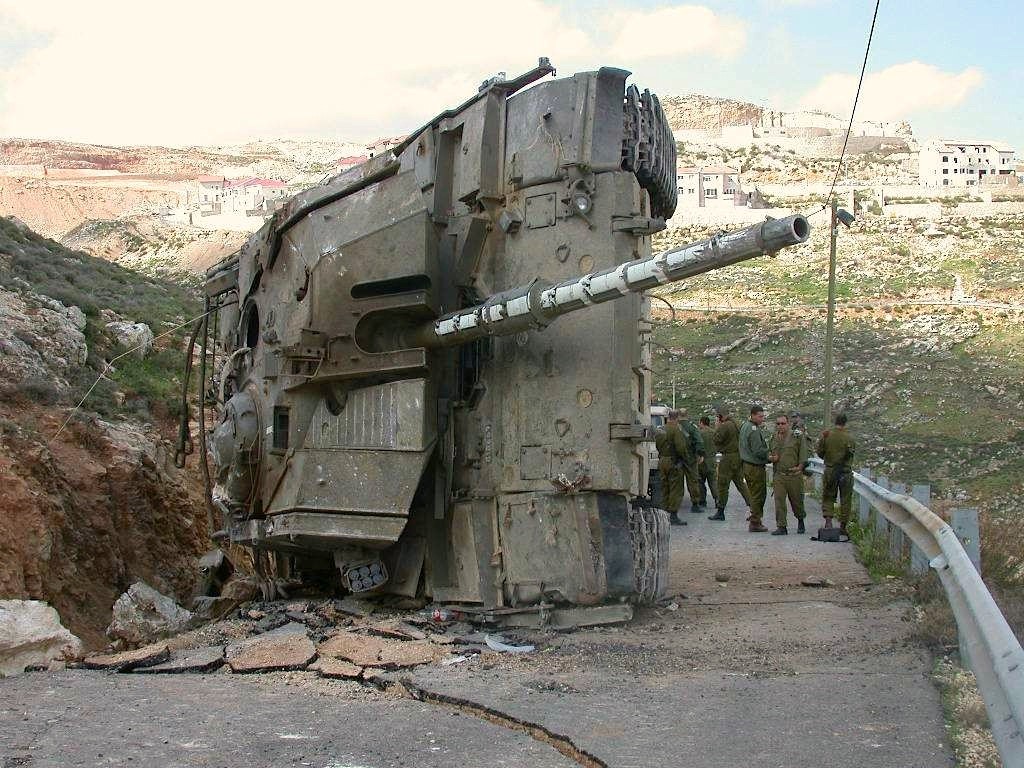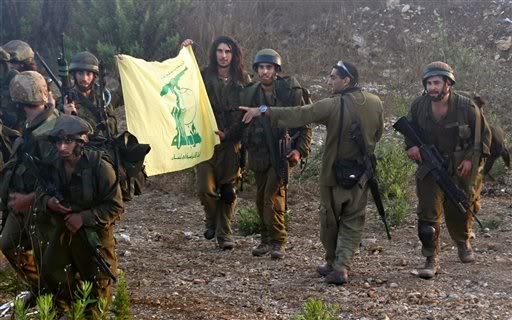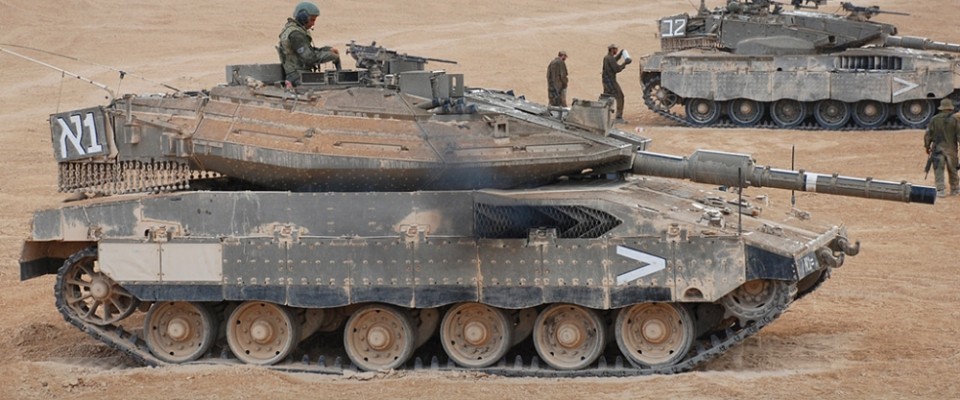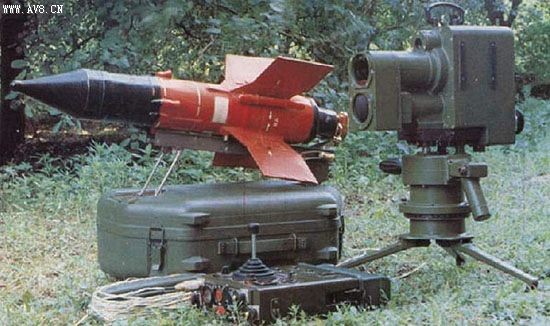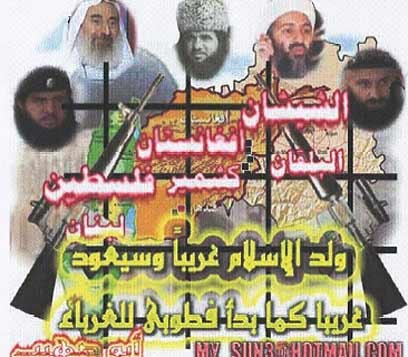Andrew McGregor
Terrorism Monitor, August 11, 2006
Rockets are not new weapons, nor are they strangers to Middle East warfare. Size, range and destructive power are all factors in the development of rocket-based strategies, the ultimate of which was the “Mutually Assured Destruction” of the Cold War. The rockets used by Hezbollah in the ongoing conflict with Israel are much smaller and are usually integrated elsewhere within the tactics of the battlefield. Hezbollah is known for innovation, however, and has developed new strategic uses for their unguided rockets, employing them as political, economic and psychological weapons. As stated by Israeli Deputy Prime Minister Shimon Peres on August 6, “Nobody understands why they started to attack, what the purpose of the attack was and why they are using so many rockets and missiles.”
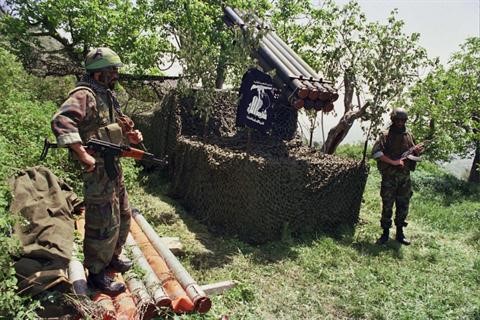 Hezbollah Fighters with Katyusha Rocket Emplacement (AP)
Hezbollah Fighters with Katyusha Rocket Emplacement (AP)
“Little Kate” (The Katyusha)
The chairman of the Knesset’s Foreign Affairs and Defense Committee described why Hezbollah has been able to keep the rockets flying despite extreme military pressure from Israel: “Hezbollah separated its leadership command-and-control system from its field organization. It created a network of tiny cells in each village that had no operational mission except to wait for the moment when they should activate the Katyusha rocket launchers hidden in local houses, using coordinates programmed long ago” (San Francisco Chronicle, July 21).
The 122mm Katyusha (range: 20-25 kilometers) is the mainstay of Hezbollah’s rocket arsenal. “Katyusha” is somewhat of a generic term today, covering a wide variety of small, unguided, solid-fuel rockets produced by a number of countries, including Iran. The Katyushas all have a common origin in the Soviet BM-8 and BM-13 truck-mounted rocket launchers that were used against the German army in 1941. Fired in short-range volleys of as many as 48 rockets at a time, they had an immediate military and psychological impact on German troops.
Hezbollah usually fires their version of the Katyusha one at a time from improvised launching facilities. Some Katyusha-type multiple-rocket launching systems were specifically designed to be dismantled into single units for guerrilla use. In 2001, the first truck-mounted launching systems were reported in Hezbollah’s arsenal, making more effective volley-launches possible. There are some recent instances of volley-firing, such as the attacks on the Israeli town of Acre on August 3.
Once in the air, the cheaply-made Katyushas are remarkably difficult to stop. A few years ago, Israel and the United States cooperated in a joint project to develop a “Tactical High Energy Laser” (THEL) to bring down such rockets by igniting the warhead in mid-air through the use of a high-energy chemical laser. In tests the system successfully destroyed several Katyusha rockets, but mobility difficulties and technical concerns related to the chemical fuel led to a cut in funding for the project in 2004. Research is underway on a more-portable version with an electrically powered laser, but production of this costly system is still years away.
The unguided Katyusha is not intended to strike a specific target. Rather, it is designed to be fired with 16 or more of its kind in a salvo that rains destruction upon a certain area, preferably a troop concentration, massed armor or fortified emplacements. By firing Katyusha-type rockets singly (often into sparsely occupied parts of Israel) Hezbollah has forgone the tactical use of this weapon for strategic purposes. Here Hezbollah signals its mastery of media warfare; the media covers wars like a sporting event, with the scorecard being the most important element in determining who is winning. Besides the daily updates of the number of troops killed, the number of civilians killed and the number of air-raids launched, the media also dutifully records the daily tally of rockets fired. Despite causing insignificant physical damage, each rocket arrives like a message of defiance, a signal to the Arab world that Israel is not invincible. Hezbollah routinely looks for new uses for existing weapons in its arsenal, and in this case they have transformed a battlefield weapon into a means of political warfare.
Bringing Tel Aviv in Range
The introduction of longer-range Iranian-made Fajr-3 and Fajr-5 rockets (also known as the Ra’ad, or by the Hezbollah name “Khaibar”) has given the conflict a new dimension, with Hezbollah no longer restricted to hitting the thinly populated Israeli north. The 240mm Fajr-3 has a range of 45 kilometers and carries a 45 kilogram warhead, while the 333mm Fajr-5 has a range of 70-75 kilometers and carries a 90 kilogram warhead. Both systems are usually truck-mounted. The Fajr-5 was first used in the July 28 attack on the Israeli town of Afula, then again in an attack on the West Bank town of Jenin on August 3. At the extreme limits of their range, the Fajr-type rockets are accurate only to within a one kilometer radius.
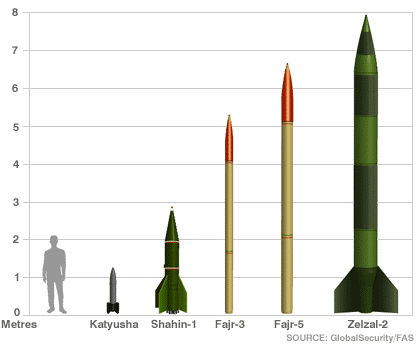 An Iranian official recently confirmed that Zelzal-2 rockets, with a stated range of 200 kilometers (although this figure may be significantly exaggerated), had been provided to Hezbollah by Iran for use “in defense of Lebanon” (Haaretz, August 5). The 610mm Zelzal-2 is a 3,500 kilogram rocket with a 600 kilogram high-explosive warhead, first delivered to Revolutionary Guard units in Lebanon in 2002. Israeli intelligence believes the missile is capable of reaching the northern suburbs of Tel Aviv. Although the rocket is unguided and difficult to use, the threat from the Zelzal-2 is taken seriously, with U.S.-made Patriot anti-missile systems deploying near Netanya to guard Tel Aviv. The Patriot system is useful only against larger, longer-range rockets, with no effectiveness against the smaller Katyusha types.
An Iranian official recently confirmed that Zelzal-2 rockets, with a stated range of 200 kilometers (although this figure may be significantly exaggerated), had been provided to Hezbollah by Iran for use “in defense of Lebanon” (Haaretz, August 5). The 610mm Zelzal-2 is a 3,500 kilogram rocket with a 600 kilogram high-explosive warhead, first delivered to Revolutionary Guard units in Lebanon in 2002. Israeli intelligence believes the missile is capable of reaching the northern suburbs of Tel Aviv. Although the rocket is unguided and difficult to use, the threat from the Zelzal-2 is taken seriously, with U.S.-made Patriot anti-missile systems deploying near Netanya to guard Tel Aviv. The Patriot system is useful only against larger, longer-range rockets, with no effectiveness against the smaller Katyusha types.
On August 3, Hezbollah chief Sheikh Hassan Nasrallah made a televised offer to Israel to stop firing Hezbollah rockets in exchange for an end to Israeli air strikes in Lebanon. The Shiite leader warned, however, that Hezbollah would fire its rockets at Tel Aviv if the Israeli Air Force attacked Beirut (al-Manar TV, August 3). It is possible that Hezbollah requires Iran’s permission to attack Tel Aviv. The largest weapons in Hezbollah’s missile arsenal are likely to be at least partially manned by members of Iran’s Revolutionary Guards.
Grapes of Wrath Revisited
The current Israeli operation bears a great similarity to Israel’s 1996 “Grapes of Wrath” operation: a massive military response to Hezbollah’s launching of Katyusha rockets into northern Israel despite the occupation of the Israeli “security zone” in southern Lebanon. Proclamations that it was time to end the “Katyusha menace” came to nothing as the offensive had little effect on Hezbollah’s rocket capabilities and took few Hezbollah lives at a great cost to Lebanese civilians. Hezbollah rocket launches were carefully tallied by the Lebanese public as a measure of the movement’s success on the battlefield. The Shiite movement was strengthened politically through armed resistance to Israel, while the Israeli government of Shimon Peres lost the next election.
Following the 2000 evacuation of the south Lebanese security zone, Israel refrained from responding directly to Hezbollah provocations along the border in mid-2001 and spring 2002. The Israeli government was aware that targeting Hezbollah would bring a flurry of rockets across the border, followed by an inevitable escalation and probable re-occupation of a region that Israel had just evacuated. For a time, at least, renewed war in south Lebanon carried too high a political price.
Conclusion
Hezbollah’s rocket strategy has successfully disrupted all activities in northern Israel, forcing 300,000 Israelis into shelters or refugee camps, and impressing upon Israelis that building a wall around their country is not enough to ensure permanent security. Israel’s war is incredibly expensive, and the deployment of the reserves creates an economic drain that is difficult for a small state like Israel to sustain. As long as Hezbollah can continue to send rockets across the border, it strikes an economic blow on its enemy. Continuing to fire the rockets also goads Israeli ground forces into military confrontation with the guerrillas on ground that Hezbollah has prepared for six years.
The size of Israel’s proposed security barrier keeps changing with the realization that even an occupation up to the Litani River (a zone 28-35 kilometers deep) will keep only Hezbollah’s short-range Katyushas from reaching Israel. A measure of this reality (and the importance of the “scorecard”) was reflected in the August 1 televised remarks of Israeli Prime Minister Ehud Olmert: “I believe one can say today…that there is no way to measure this war according to the number or range of the rockets being fired at us. From the very first day, neither I, nor the defense minister, nor the Israeli government, nor the military leadership—and this is to its credit—ever promised for even one moment that when the fighting ended, there would be absolutely no rockets within firing range of the State of Israel. No one can make such a promise” (Israel TV Channel 1, August 6).
The resistance of Hezbollah fighters, the severity of the Israeli bombing campaign and the inability of Israel to halt the rockets has resulted in unusually broad popular support for Hezbollah both in Lebanon and a politically frustrated Arab world. When ceasefire negotiations begin, it will now be difficult for the Arab regimes that opposed Hezbollah at the beginning of the conflict (particularly Egypt, Jordan and Saudi Arabia) to ignore Hezbollah’s calls for at least diplomatic support from the Arab states. In the meantime, Hezbollah’s rocket campaign continues to destroy little militarily while it accomplishes much politically, economically and psychologically.
This article first appeared in the August 11, 2006 issue of the Jamestown Foundation’s Terrorism Monitor

